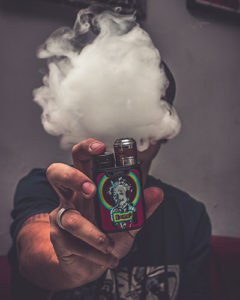There’s no avoiding it: this mysterious vaping illness is all over news outlets and social media. Until recently, vaping dangers have been clouded (no pun intended) by smoke ring competitions, “vape God” trick videos on Instagram, and Candy Land resident worthy flavors. But that all changed when the first vape-related death was announced in Illinois on August 23. Since then, six vape-related deaths have been reported.
While the news goes wild with buzzwords like cancer, lung disease, addiction, and death, current vape users are left panicking… is vaping really that dangerous?
Vaping Illness Timeline
- One of the earlier vaping illness investigations traced concerns to April of this year. Illinois and Wisconsin state health departments tracked 53 patients who reported symptoms. Typical early symptoms included chest pain, coughing, and shortness of breath. Some patients also reported nausea, vomiting, diarrhea, fever, and fatigue. A majority of these patients ended up hospitalized and about a third of them required respirators.
- On August 17, the Centers for Disease Control and Prevention (CDC) announced an ongoing investigation of almost 100 possible cases of severe lung illness related to vaping. Less than a week later on August 23, the CDC confirmed the first reported vape-related death in Illinois.
- At the end of August, the CDC released an emergency warning regarding severe pulmonary disease, specifically citing vaping products that contain THC and/or CBD. In response, former FDA commissioner Scott Gottlieb explained that the specification does not “let legally sold, nicotine-based e-cigarettes off the hook.”
- Just last week on September 10, the Kansas Department of Health announced the sixth vape-related death.
Why Now?
Vapes and e-cigarettes have been around for over a decade, so why is this mysterious vaping illness and associated deaths happening now?


 The CDC explains they’re still investigating whether this is a new illness or if it has just gone relatively unnoticed for years. Some officials lean toward the illnesses being newly recognized. Susan Walley, chair of the American Academy of Pediatrics tobacco control section, for example, believes that younger users might not consider their use of newer vape models (like Juul) as actually vaping. If this is true, it’s a huge cause for concern because a large chunk of vapers are younger. A US survey released last December revealed that 37% of high school seniors reported vaping over the past year. Most of the CDC’s reported vaping illness victims were younger users as well.
The CDC explains they’re still investigating whether this is a new illness or if it has just gone relatively unnoticed for years. Some officials lean toward the illnesses being newly recognized. Susan Walley, chair of the American Academy of Pediatrics tobacco control section, for example, believes that younger users might not consider their use of newer vape models (like Juul) as actually vaping. If this is true, it’s a huge cause for concern because a large chunk of vapers are younger. A US survey released last December revealed that 37% of high school seniors reported vaping over the past year. Most of the CDC’s reported vaping illness victims were younger users as well.
However, others argue that there’s no way this type of urgent illness would have gone unnoticed in the past. The fact of the matter is e-cigarettes just hadn’t been around long enough for extensive research to take place. Now, with a plethora of model variations, the constant emergence of new flavors, a somewhat significant amount of time since inception, and more and more regular users, we’re starting to receive results and they aren’t good.
What’s Causing the Vaping Illness?
The investigation is ongoing, but early signs are pointing to the chemicals as a significant potential cause of the illnesses.
Vapes are used with vape juice or e-cigarette liquid. The base of vape juice is typically propylene glycol, vegetable glycerin, or a combination of both. Most also contain nicotine and flavorings. All of this is heated to vapor before entering the body through the respiratory system.
So far, the investigation hasn’t found a link between any particular vaping products and the vaping illness. Some speculations point towards the vitamin E acetate chemical found in the marijuana products used by many of the victims. But officials claim they still can’t pin the illnesses on any one component yet, especially after some of the victims claimed to have only smoked nicotine products containing no marijuana.
On the Front Lines
While the investigation wages on against these sudden deaths, officials are advising that users stop vaping immediately until further notice.
The FDA had been pushing back its deadline to review e-cigarette products for a couple of years now. Ned Sharpless, acting FDA Chief, released a series of tweets explaining that they’re still working on the investigation and consumers should avoid buying vaping products off the street. He also explained that their ongoing focus is to address the teen vaping epidemic.
But many lawmakers don’t approve of the somewhat lax message from the FDA. Senator Dick Durbin, for example, tweeted in response:
“The vaping epidemic has now reached the point where multiple people have died and over 450 have been hospitalized, but [Ned Sharpless] is sitting on his hands.”
The senator threatened to call for the FDA Chief’s resignation if he does not quickly take action.
San Francisco, home of Juul Labs, which is the biggest producer of e-cigarettes in the US, has even voted unanimously to ban the sale and distribution of e-cigarettes in the city. City Attorney Dennis Herrera, who co-authored the ordinance, states, “If the federal government is not going to act, San Francisco will.”


The Bottom Line
People are dying from vaping. The specific causes are still being investigated, but that’s the bottom line.
People are being hospitalized and dying from vaping illness and authorities are advising against buying and using vaping products.
Vaping may have not yet killed as many as conventional cigarettes or be as insidious as heroin addiction, but can anyone support a habit that is hospitalizing and killing people? And, on top of that, the definite causes are still a mystery.
Today’s e-cigarettes may look like harmless USBs and taste like they came from the Gumdrop Mountains or Lollipop Woods, but the reality is far more noxious.
While vapes do contain nicotine, their addictive qualities are not yet a concern for substance abuse treatment. If you or a loved one are struggling with a threatening drug or alcohol addiction, our specialists are available 24/7 to help: 714-203-2708*
*all calls are operated by New Start Recovery




